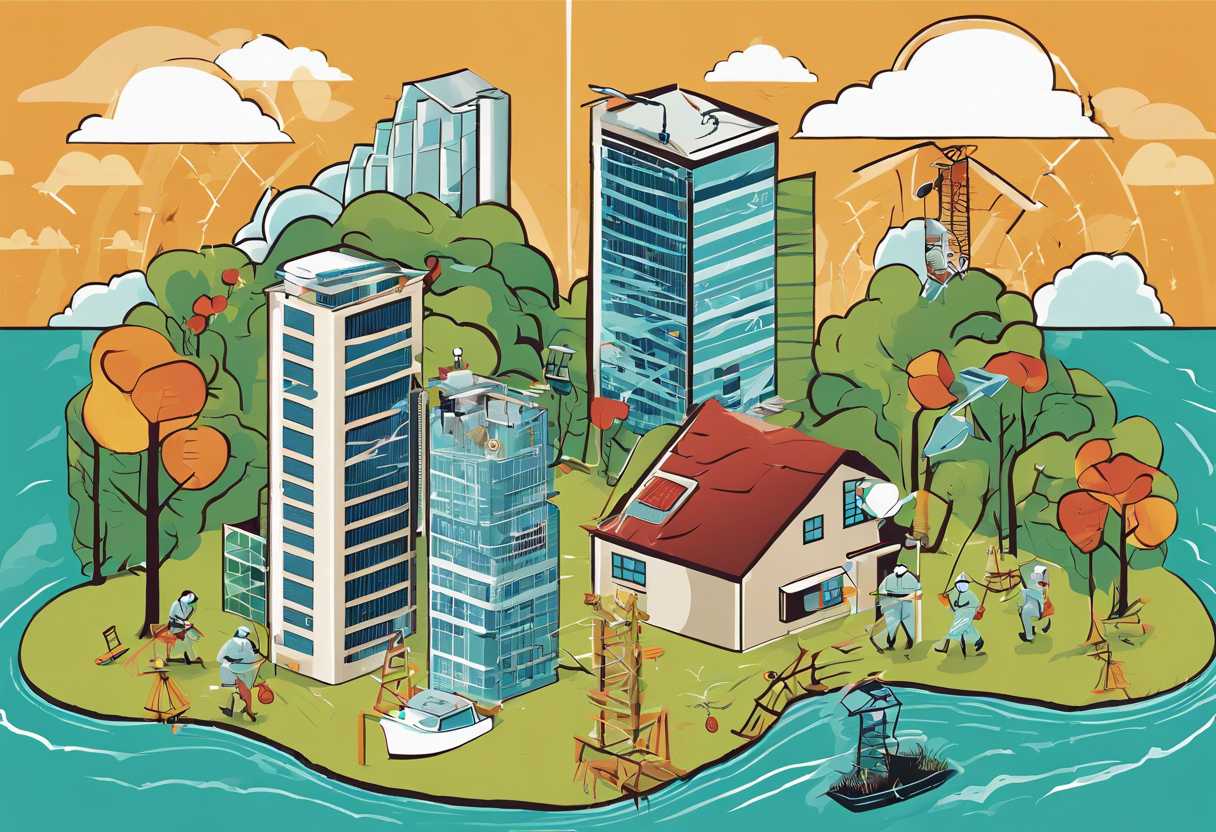Disaster Risk Reduction has become an increasingly critical issue in today’s world, as communities face the growing threat of natural and man-made disasters. Understanding the importance of Disaster Risk Reduction is essential for safeguarding lives, livelihoods, and infrastructure. This blog post will delve into the significance of Disaster Risk Reduction and explore effective strategies for its implementation in communities.
Implementing effective strategies for Disaster Risk Reduction is crucial for minimizing the impact of disasters and enhancing community resilience. This post will discuss various approaches and best practices for reducing disaster risk, including early warning systems, land-use planning, and infrastructure development.
The role of technology and innovation in Disaster Risk Reduction cannot be overstated. This blog will highlight the latest technological advancements and innovative solutions that are being utilized to mitigate disaster risk and enhance preparedness.
Building resilience and preparedness through Disaster Risk Reduction initiatives is a key focus area of this post. We will explore the importance of community-based approaches, capacity building, and education in fostering resilience and preparedness.
Collaborative approaches to Disaster Risk Reduction are essential for engaging stakeholders and communities in the process. This blog will examine the importance of multi-stakeholder partnerships, community participation, and inclusive decision-making in Disaster Risk Reduction efforts.
Stay tuned as we delve deeper into these critical aspects of Disaster Risk Reduction and provide valuable insights and recommendations for addressing this pressing global challenge.
Understanding the Importance of Disaster Risk Reduction in Today’s World
The Growing Threat of Disasters
With the increasing frequency and severity of natural disasters such as hurricanes, earthquakes, and wildfires, it has become more important than ever to prioritize disaster risk reduction. These events not only cause widespread destruction and loss of life, but also have long-term impacts on communities, economies, and the environment. It is crucial for governments, organizations, and individuals to understand the significance of disaster risk reduction and take proactive measures to mitigate the potential impact of these events.
Building Resilient Communities
Disaster risk reduction involves a range of strategies and actions aimed at minimizing the vulnerabilities of communities and increasing their resilience to disasters. This includes measures such as improving infrastructure, implementing early warning systems, and promoting sustainable land use practices. By investing in disaster risk reduction, communities can better prepare for and respond to disasters, ultimately reducing the overall impact and facilitating quicker recovery.
The Role of International Cooperation
Disasters do not recognize borders, and their impacts can often extend beyond national boundaries. International cooperation is therefore essential in addressing the challenges posed by disasters. By sharing knowledge, resources, and expertise, countries can work together to strengthen disaster risk reduction efforts on a global scale. This collaboration can lead to more effective risk assessment, early warning systems, and response mechanisms, ultimately benefiting all nations and their populations.

Implementing Effective Strategies for Disaster Risk Reduction in Communities
The Importance of Disaster Risk Reduction
Disasters can have devastating effects on communities, causing loss of life, destruction of infrastructure, and economic hardship. Implementing effective strategies for disaster risk reduction is crucial in minimizing the impact of these events and ensuring the safety and resilience of communities.
Community-Based Approaches to Disaster Risk Reduction
One effective strategy for disaster risk reduction is the implementation of community-based approaches. These approaches involve engaging and empowering local communities to take an active role in identifying and addressing their vulnerabilities to disasters. By involving community members in the planning and implementation of risk reduction measures, it is possible to create more sustainable and effective solutions.
- Community risk assessments
- Capacity building and training
- Early warning systems
Building Resilient Infrastructure
Another important aspect of disaster risk reduction is the construction of resilient infrastructure. This includes building and retrofitting structures to withstand natural hazards such as earthquakes, floods, and hurricanes. Investing in resilient infrastructure not only reduces the risk of damage and loss of life during disasters but also contributes to the long-term sustainability of communities.
| Resilient Infrastructure | Benefits |
| Earthquake-resistant buildings | Reduced risk of collapse |
| Flood-resistant drainage systems | Minimized water damage |
| Hurricane-proof shelters | Increased safety during storms |

The Role of Technology and Innovation in Disaster Risk Reduction
Early Warning Systems
One of the key roles of technology in disaster risk reduction is the development and implementation of early warning systems. These systems use various technological tools such as sensors, satellites, and communication networks to detect and monitor potential disasters such as earthquakes, tsunamis, and extreme weather events. By providing timely and accurate information, early warning systems help to minimize the impact of disasters on communities and infrastructure.
Geographic Information Systems (GIS)
GIS technology plays a crucial role in disaster risk reduction by providing valuable spatial data and analysis tools. By mapping and visualizing risk areas, vulnerable populations, and critical infrastructure, GIS helps decision-makers to better understand and plan for potential disasters. This technology also enables the development of effective evacuation plans, resource allocation, and post-disaster recovery efforts.
Drones and Remote Sensing
Drones and remote sensing technologies have revolutionized disaster response and recovery efforts. These tools are used to assess damage, identify hazards, and monitor the progress of relief operations in hard-to-reach or hazardous areas. By providing real-time imagery and data, drones and remote sensing technologies enable responders to make informed decisions and prioritize their efforts effectively.
Building Resilience and Preparedness through Disaster Risk Reduction Initiatives
The Importance of Disaster Risk Reduction Initiatives
Disasters can strike at any time, and their impact can be devastating. This is why it is crucial to invest in disaster risk reduction initiatives. These initiatives aim to minimize the vulnerabilities of communities and increase their capacity to cope with and recover from disasters. By implementing measures such as early warning systems, infrastructure improvements, and community preparedness programs, the impact of disasters can be significantly reduced.
Key Components of Disaster Risk Reduction Initiatives
Disaster risk reduction initiatives encompass a wide range of activities and measures. Some key components include:
- Assessing and understanding the risks
- Building and strengthening infrastructure
- Developing early warning systems
- Implementing community-based disaster preparedness programs
The Role of Technology in Disaster Risk Reduction
Technology plays a crucial role in disaster risk reduction initiatives. From advanced early warning systems to innovative building materials, technology can greatly enhance the resilience and preparedness of communities. For example, the use of geographic information systems (GIS) can help identify high-risk areas and inform decision-making processes. Additionally, the development of mobile applications for disaster preparedness and response can empower individuals to take proactive measures to protect themselves and their communities.
Collaborative Approaches to Disaster Risk Reduction: Engaging Stakeholders and Communities
The Importance of Stakeholder Engagement
Engaging stakeholders in disaster risk reduction efforts is crucial for creating effective and sustainable solutions. By involving a wide range of individuals and organizations, we can tap into diverse expertise, resources, and perspectives. This collaborative approach helps to ensure that disaster risk reduction strategies are comprehensive and inclusive, taking into account the needs and priorities of all stakeholders.
Community Involvement in Disaster Risk Reduction
Communities play a vital role in disaster risk reduction, as they are often the first responders in times of crisis. By involving local residents in the planning and implementation of risk reduction measures, we can build resilience from the ground up. This can include community-based early warning systems, training in disaster preparedness, and infrastructure improvements that are tailored to the specific needs of each community.
Case Study: Successful Collaborative Disaster Risk Reduction Project
One example of a successful collaborative disaster risk reduction project is the partnership between local government, non-governmental organizations, and community groups in a flood-prone region. Through a combination of infrastructure improvements, community education programs, and early warning systems, the project has significantly reduced the impact of flooding on local residents. This multi-stakeholder approach has not only saved lives and property but has also fostered a sense of ownership and empowerment within the community.
Conclusion
Disaster Risk Reduction is an essential aspect of modern society, and its importance cannot be overstated. As we have explored in this blog post, effective strategies for disaster risk reduction are crucial for building resilient and prepared communities. The role of technology and innovation in disaster risk reduction cannot be ignored, as they offer valuable tools and solutions for mitigating risks and enhancing preparedness.
Furthermore, collaborative approaches to disaster risk reduction, involving stakeholders and communities, are key to creating sustainable and effective initiatives. By engaging all relevant parties, we can ensure that disaster risk reduction efforts are comprehensive and inclusive, leading to better outcomes for all.
As we move forward, it is imperative that we continue to prioritize disaster risk reduction in our communities and beyond. By implementing the strategies and approaches discussed in this blog, we can work towards a safer and more resilient future for all. Let us all take an active role in disaster risk reduction and contribute to building a more secure world for generations to come.
Remember, disaster risk reduction is not just a concept – it is a responsibility that we all share. Together, we can make a difference and create a world that is better prepared and more resilient in the face of potential disasters.
Thank you for reading and for your commitment to disaster risk reduction.

